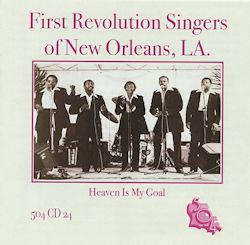
BUY NOW AmazonUK AmazonUS |
FIRST REVOLUTION SINGERS OF Orleans, LA Heaven Is My Goal |
1. Fire
2. Gospel Train
3. He Really Cares
4. I’ll Fly Away
5. Down by the Riverside 1986
6. Amazing Grace
7. I’ve Been Changed
8. I’ve Got the Love of Jesus in My Heart
9. When the Saints Go Marching In
10. My Life
11. Running for Jesus
12. Down by the Riverside Pt. 2
13. Soldier
14. Anonymous Love
15. It’s Gonna Rain
16. Down by the Riverside Pt. 3
17. Please Remember Me
18. He
19. Family Circle
20. There’s Room (at the Cross)
21. Heaven Is My Goal
22. I Don’t Want To Be Lost
23. He’s Okay
24. I’m Gonna Serve the Lord
25. Amazing Grace 1988
26. Oh Mary Don’t You Weep
Tracks 1-9
James Riley (Nicky)
Cornell Coulon
Lynwood Bell
Larry Bell
Harold Miller Earl Manning (Walter)
Gerry Cannon (added on track #6)
Recorded at Night Shade Studio, New Orleans, LA, on Oct. 17, 1986.
Originally released on 504 LPS 14.
Tracks 10-12
Same as above
Originally released on 504 TCS 101 G.
Tracks 13-26
Larry Bell
Harold Miller
Cornell Coulon
Jerome G. Alexander
George Hunter
Recorded at Sounds Unlimited, Kenner, LA, on Sep. 17, 1988.
Originally released on 504 LPS 24.
As the traditional jazz revival got under way in the 1950s and beyond, the impetus to record the various groups, especially those in New Orleans, came from small independent labels formed for the purpose. (The bigger labels only got involved when they saw a chance to add to their bottom line, and quickly dropped out when the bonanza did not materialize.) One of these small companies was 504 Records, founded in 1979 by the late Mike Dine, specifically to record such jazz. Later the scope was broadened to “music of New Orleans,” a rubric which would include gospel.
Religious music and jazz have always been compatible—one only has to look at the tune lists of almost any traditional jazz band to find many gospel tunes and spirituals therein, and quite often gospel singers such as Sister Rosetta Tharpe, Alex Bradford, and Sister Lottie Peavey recorded with jazz bands. Also jazz bands such as those of Kid Howard and George Lewis played (and recorded) at church services. So it is quite fitting that 504 Records should have issued on LP—and now reissued on CD—these performances by the First Revolution Singers on New Orleans, LA, a group formed in 1972, just a few years before the debut of 504 Records.
That said, it has to be admitted that jazz does not figure prominently in tracks of this CD as there is no jazz instrumental accompaniment, although one can see at a glance that several of the tunes are part of many traditional jazz bands’ repertoires:I’ll Fly Away; Down by the Riverside; Family Circle (a.k.a.Shall the Circle Be Unbroken?);Oh Mary Don’t You Weep; and, of course, W hen the Saints Go Marching In. The group is a seasoned one, with the tight harmonies that we expect of such a capella performances. In many of the tracks one voice simulates a string bass, and various percussion effects are achieved by finger snapping, tapping on a microphone, etc.
The renditions of some of these tuners are quite moving, and devotees of gospel singing will be transported. While I do not qualify as such, I was thoroughly entertained, especially when comparing and contrasting the presentation here with that given by jazz bands I have heard playing those same pieces. The close harmonies of the several voices are similar to those the members of a jazz front line can establish during ensemble passages, whether improvised or scored. The lines of the lead singer often evoke a response from the rest of the group, much like the call-and-response between a preacher and the congregants or the type of interaction to be heard in a traditional jazz band when the rest of the ensemble engages in a conversation with the lead instrument.
Perhaps the most unusual track, and my favorite on this disc, is Soldier—an inspiriting march, complete with cadence calling and vocal “instruments” and other sound effects (boots tramping, shells passing and exploding, etc.) all done by voice and or hand clapping and finger snapping and perhaps a tap on the microphone. Probably this and the tracks that follow it were done by a quartet (often the gospel group size) in each case, the fifth person being responsible for any “sound effects.” (The first twelve tracks have seven performers’ names listed.)
An unexpected (for gospel) comic moment comes in the final track, the gospel song Oh Mary Don’t You Weep which, with its underlying theme of “freedom,” tells of Mary and Martha, whose brother Lazarus had died, leaving Mary quite distressed and begging for him to be restored to life. Allusions to Pharaoh’s army being drowned in the Red Sea and to the rock on which Moses parted the Red Sea suggest God’s intervention and miracle working. The constant repetition of allusions to these events causes the lead singer to expostulate in exasperation, “Oh, come on, Mary!” (Lazarus’ was, as we know, ultimately raised from the dead.) So the program concludes not with tears but with a smile.
This is a CD whose primary appeal will be to fans of gospels and spirituals, but jazz fans should find it congenial, too. With successive auditions I have found it ever more appealing.
Bert Thompson